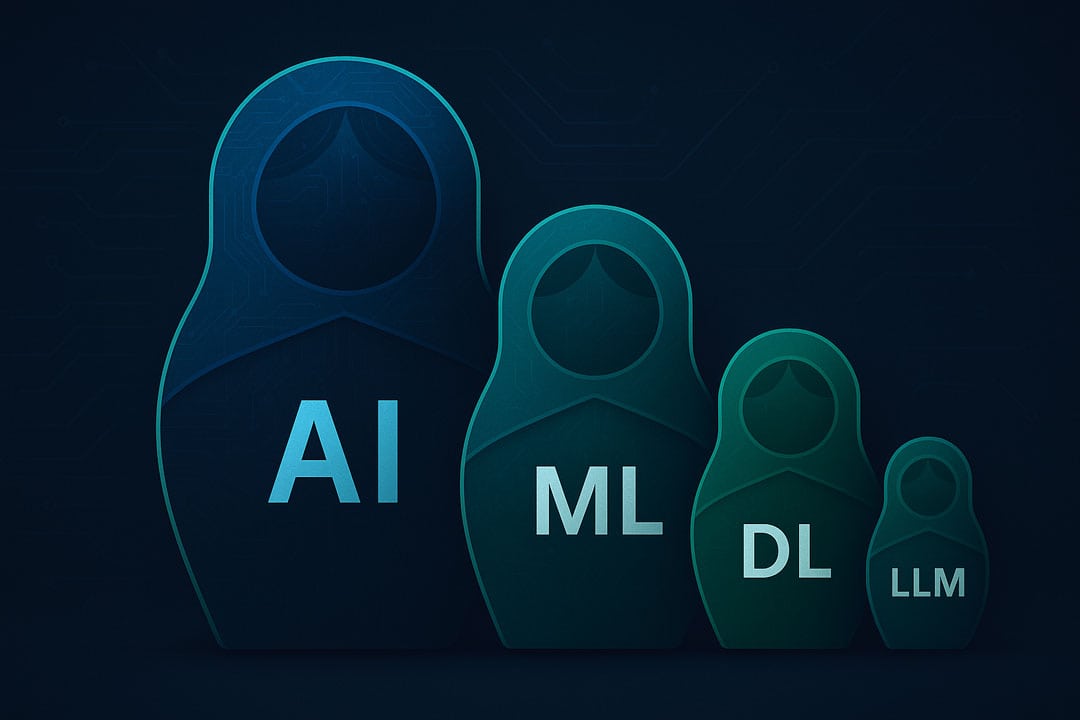
AI Workflow vs AI Agent: Understand the Difference Before Automating
Learn when to use an AI-enhanced workflow or an AI agent, how they differ, and which approach fits your operations. Includes an AI task prioritization grid.

Artificial Intelligence (AI) is everywhere, powering your smartphone, search results, and the apps you use daily. But few people can explain what AI really is, let alone what makes tools like ChatGPT or Claude possible.
Spoiler: they’re built on something called an LLM — a Large Language Model.
In this article, you’ll learn in simple terms:
Whether you’re curious, tech-savvy, or leading digital initiatives in your company, this is the mental model you need to understand today’s AI, and start using it effectively.
Summary:
AI is the ability for machines to simulate human intelligence. Not just calculations, but actual cognition: understanding, reasoning, learning, even decision-making.
The best analogy?
A child’s brain at birth = full of neurons but no knowledge.
As they grow, their brain learns by absorbing experiences.
Now imagine doing that — digitally.
That’s what we call a neural network: a system of algorithms trained to recognize patterns in data.
AI is a digital brain that learns from exposure — just like a human — but at scale and speed no human can match.
Let’s break it down:
Think of AI like a set of Russian nesting dolls:
At the outer layer, you have Artificial Intelligence.
Inside it sits Machine Learning, then Deep Learning, and finally — at the smallest, most specialized layer — you find LLMs & the AI agents.
LLMs are just one branch of AI, but they’re arguably the most disruptive when it comes to how we work with knowledge, language, documents, and automation at scale.
Training an LLM is like accelerating a human’s lifetime of reading into a few weeks or months.
Step by step:
And unlike humans, it doesn’t forget.
LLMs are not just trained on what words mean, but on how humans use them, across every context imaginable.
Think of an LLM as:
Common use cases:
If you can explain the task in natural language, an LLM can probably help automate it.
Words are one thing. Seeing it in action is another.
No slides. No sales talk. Just a hands-on walkthrough of what automation looks like when it’s built for real-life operations.

Because AI is not a future trend. It’s a current advantage.
Whether you’re in:
LLMs can reduce repetitive tasks, compress timelines, and increase precision across your workflows.
If your competitors are already using them and you’re not, you’re falling behind, quietly but surely.
“An LLM is a digital neural network we’ve brought into existence. And instead of waiting 20 or 30 years for it to become an expert, we can inject practically all the knowledge available online into this digital brain — and make it grow incredibly fast.”
Why are LLMs called “digital brains”?
Because they learn, reason, and respond like humans — but in seconds, across billions of data points.
What can a LLM do in a business context?
Summarize, translate, extract data, generate content, and automate complex tasks via natural language.
Does it replace traditional automation?
Yes — and more. LLMs don’t just run scripts; they adapt and make context-based decisions. That’s the power of AI agents.
Can it connect to our systems?
Yes. Through APIs, ERP data, files, and business rules. The LLM integrates into your existing workflows seamlessly.
Subscribe to receive our exclusive updates directly to your email.

Tell us more about your needs so that we can better route your project to our specific SWAT team.
1
During the brainstorming phase, we work with you to identify potential solutions to your business challenges to generate the technology response that aligns with your business objectives.
2
Through our requirements gathering process, we work closely with you to define and prioritize your needs, ensuring that our solutions are tailored to meet your specific requirements.
3
This phase marks the beginning of our partnership. We’ll finalize the project plan and establish clear communication channels to ensure a smooth and successful project execution.